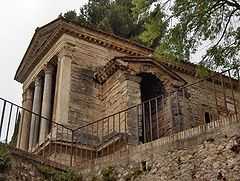Temple of Clitumnus


| Wikimedia Commons has media related to Tempietto del Clitunno. |
The Tempietto del Clitunno (Temple of Clitumnus) is a small paleochristian church that sits along the banks of the Clitunno River near the town of Campello sul Clitunno between Spoleto and Trevi, Umbria, Italy. In 2011, it became a UNESCO World Heritage Site as part of a group of seven inscribed as Longobards in Italy. Places of the power (568-774 A.D.).
There was originally a pagan shrine dedicated to the river god Clitumnus, built along the Via Flaminia, the road from Rome to Ariminum (Rimini). It was described by Pliny the Younger in his Epistulae book VII, 8: "Next to it [to the river] stands an ancient and venerable temple in which is placed the river-god Clitumnus clothed in the usual robe of state; and indeed the prophetic oracles here delivered sufficiently testify the immediate presence of that divinity". A popular touristic spot in Roman times, it attracted Roman citizens and emperors alike to consult and to worship the oracles of the river god. Also mentioned in book II of Virgil's agrarian work The Georgics: " Hence thy white flocks, Clitumnus, and the bull, Of victims mightiest, which full oft have led, Bathed in thy sacred stream, the triumph-pomp Of Romans to the temples of the gods."
16th century humanist thought that the tempietto had been converted from a pagan temple into an early-Christian church, dedicated to San Salvatore, probably in the fourth century. It was however probably built from the ground up in several stages, constructed from the beginning for Christian use, using materials taken from the numerous mausoleums and Roman villas that surrounded the river and the lake. This can be clearly seen by the Corinthian column screens, the tympanum reliefs with a cross surrounded by vine scrolls and the Latin inscriptions in Roman square capitals from its friezes.
- SANCTUS DEUS ANGELORUM QUI FECIT RESURRECTIONEM
- SANCTUS DEUS APOSTOLORUM QUI FECIT REMISSIONEM
- SANCTUS DEUS PROPHETARUM QUI FECIT REDEMPTIONEM
Inside on the rear apse walls of the tempietto one can see the faded traces of two eighth-century frescoes of Jesus and St. Peter and St. Paul. These are the oldest frescoes in Umbria. They resemble the frescoes in Santa Maria Antiqua, a 5th-century church in Rome. These frescoes were painted over between the years of 1931 and 1933, but were fully cleaned in 1985. The apse also contains a reliquary and a column screen, much like the one in the Pantheon in Rome.
Many additions have been made to the Tempietto during multiple restoration projects, the most notable being 1890-1894, including new stone in the apse floor, benches in the corners of the nave, and a stairway to replace the one torn down in the 1730s on the north portico. The construction of a highway has also contributed to the altered setting of the Temple.
References
- Emerick, Judson (1998). The Tempietto del Clitunno near Spoleto. Penn State Press. pp. vol.1 + vol. 2. ISBN 978-0-271-01728-0.
- C. Plinius Caecilius Secundus, Epistulae liber VIII, 8 (in Latin)
| ||||||||||||||||||||||||||
| |||||
